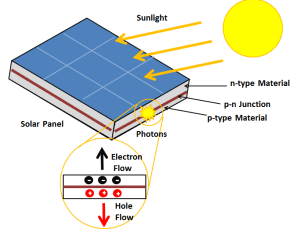So, how can we utilize solar energy? What is photovoltaic power generation? And how does a solar panel work? Today, let’s explore it all.
How can we utilize solar energy?
Photothermal conversion
- Definition: refers to the process of converting solar radiant energy into thermal energy. After the light energy in solar radiation is absorbed by the absorbing material, through the energy transfer mechanism inside the material, the temperature of the material rises, thus converting solar energy into thermal energy.
- Applications: building daylighting and heating, greenhouse, solar water heater, solar thermal power generation system.
Note:
Solar thermal power generation system: refers to a system that uses a concentrating device to collect and focus solar radiant energy, convert it into thermal energy and transfer it to a heat transfer medium, and then generate steam to drive a steam turbine to drive a generator to generate electricity, thereby converting solar energy into electrical energy.
Photovoltaic conversion
- Definition: refers to the process of directly converting solar radiant energy into electrical energy. When sunlight shines on a material with a photoelectric effect (usually a semiconductor material), the energy of photons is absorbed by electrons in the material, enabling the electrons to obtain sufficient energy to break free from the bondage of atoms and generate directional movement, thereby forming an electric current and realizing the conversion from solar energy to electrical energy.
- Applications: solar photovoltaic power generation, photochemical utilization (hydrogen production by water splitting).
Note:
Unlike photothermal conversion, photovoltaic conversion does not need to convert solar energy into thermal energy. Instead, it directly uses the energy of photons to excite electrons and generate an electric current.
How does a solar panel work?
At present, with the continuous progress of technology and people’s pursuit of environmental protection, the applications of photovoltaic conversion are more extensive. Behind these applications, there is a key core component that plays a crucial role, and that is the solar panel.


Infographic by ideasforus
Let’s first explain the working principle of solar panels in a simple and easy-to-understand way.
- Basic composition of a solar panel – P-N junction
- Solar panels are composed of many small solar cell units. These cells are made of semiconductor materials, and a very important part of semiconductor materials is the P-N junction.
- The P-type semiconductor is like having many “small houses of positive charges” (holes), and the N-type semiconductor is like having many “small residents of negative charges” (electrons). When the P-type and N-type semiconductors are placed together, a P-N junction is formed at their junction.
- The role of light
- When sunlight shines on the solar panel, photons with energy collide with the atoms in the semiconductor. If the energy of the photon is large enough, it will knock the electron out of the “embrace” of the atom, which generates an electron-hole pair.
- Near the P-N junction, there is a built-in electric field. This electric field is like a “little traffic policeman” that will direct the newly generated electrons to go to the N-type semiconductor side and the holes to go to the P-type semiconductor side. In this way, electrons and holes are separated, and a voltage is generated at both ends of the solar panel.
- Formation of current
- When we connect the two ends of the solar panel with a wire, electrons will run from the N-type semiconductor end to the P-type semiconductor end through the wire to fill those holes. In this way, a continuous current is formed. Just like water flowing from high to low, the current can flow out of the solar panel and supply power to electrical appliances.
In short, when sunlight shines on the P-N junction of a semiconductor, new hole-electron pairs will be formed. Under the action of the P-N junction electric field, holes flow from the P region to the N region, and electrons flow from the N region to the P region. After the circuit is connected, a current is formed.
If you want to understand the principle of solar panels more clearly, please watch the following video:
vedio by TED-Ed
Different types of solar panel
|
Type |
Pros |
Cons |
|
Monocrystalline silicon |
|
|
|
Polycrystalline silicon |
|
|
|
Amorphous solar panel |
|
|
In the next article, we will further introduce the specific application scenarios, installation and usage and other contents of solar panels. Stay tuned!
You may also be interested in pages below
- Alibaba – Gidita Life
- Ecer – Gidita Solar
- Amoy Brand – Gidita Solar
- Gidita Solar
- Solar System & Application FAQs
- Distinction Between Off-Grid, On-Grid, and Hybrid Solar System? No More Confusion, all in 1 Basic Article!
- The 4 Most Popular Solar Lights
- What is a solar lighting system? 6 Things You Need to Know About the Exciting Green Energy Lighting Solution!
- Why Balcony Solar Systems Become Booming All the World? Your Balcony can be a 100% Powerful Energy Hub!
- The Principle and Application of Solar Water Pumps: The Magic Power that Turns Sunlight into Water
- A Portable Power Station: Your Reliable Companion to On-the-Go Life Adventures! Learn All about A Portable Power Station in 1 article.
- From traditional refrigerators to solar refrigerators, what exactly has changed?
- The Magical Box of Energy Conversion: Solar Inverter! Everything You Want to Know is in 1 article!


Xiamen Geno Industry Co,. Ltd.
Tel / WhatsApp: +86 13906057667
Email: cathy@geno-china.com

